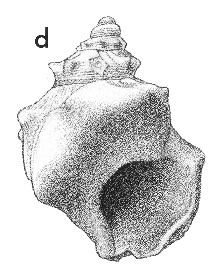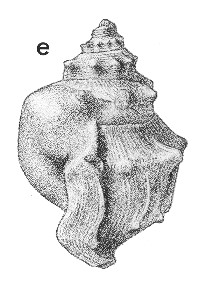
Revised descriptions of New Zealand Cenozoic Mollusca from Beu and Maxwell (1990)

 | Revised descriptions of New Zealand Cenozoic Mollusca from Beu and Maxwell (1990) | 
|
  (Pl. 29d): GS5740, S27/f8622, Hurupi Stream, Palliser Bay, southern Wairarapa, early Tongaporutuan (GNS) |
  (Pl. 29e): GS5740, S27/f8622, Hurupi Stream, Palliser Bay, southern Wairarapa, early Tongaporutuan (GNS) |
Beu & Maxwell (1990): Chapter 13; p. 260; pl. 29 d,e.
Synonymy: Struthiolaria callosa Marwick 1924b, p. 182; Struthiolaria armata Marwick 1924b, p. 183; Struthiolaria fortis Marwick 1924b, p. 183
Type species of Callusaria Finlay, 1926
Classification: Struthiolariidae
Description: Large for subgenus (40-70 mm high), short and wide, with moderately short spire (about equal to height of aperture) and enormously developed parietal callus pad; except for narrowly pointed nodules at peripheral angulation and smaller ones on weaker peribasal angulation on last whorl, the only sculpture is very faint, low spiral threads on early spire whorls. Aperture large, oval; outer lip thickly callused to form wide varix, strongly bisinuate. Inner lip expanded into most extreme callus of any mid-late Cenozoic struthiolariid, a huge pad of semicircular cross-section riding over peripheral nodules to lap onto lower part of previous whorl (forming polished, irregular band of callus around penultimate whorl below periphery), curving around parietal lip to ride over peribasal angulation as well to form large, knob-like protrusion to left of aperture, then rapidly contracting to low but still wide sheet on previous whorl, meeting outer lip at shallow anterior notch of aperture. Protoconch not seen, presumably as in S. calcar and S. spinosa, above.
Comparison: Struthiolaria callosa was apparently a direct descendant of the Altonian to Clifdenian S. spinosa (Pl. 20b), differing in its hugely developed parietal callus, its shorter form (in most specimens) and its absence of spiral sculpture on the last whorl. By this definition, S. armata and S. fortis are variants of S. callosa, although this needs confirmation from detailed population studies. At Clifden, Southland, S. spinosa reappears in the Waiauan Nissen Shellbeds, after S. callosa had evolved in the North Island. S. callosa was succeeded abruptly in Kapitean-Opoitian rocks by S. obesa (Pl. 36i) which is smaller, still shorter, more weakly callused, and less nodulose than S. callosa, and bears spiral threads all over. It lacks the smooth callus band on the ramp of the previous whorl caused by the apertural callus extending high onto the shoulder, and most specimens lack peripheral nodules altogether.
Marwick (in an unpublished oil company report, 1960) reconsidered this evolutionary series and tried to evaluate changes in the height of the spire, number and prominence of the peripheral nodules, prominence of the apertural callus, and extent to which the parietal callus rides up over the nodules onto the sutural ramp, leaving a callus smear on the previous whorl. Allowing for some re-dating of localitities, this provides some possibility of recognising S. fortis (= S. armata) as an intermediate form in a lineage leading from S. spinosa to S. callosa, although he admitted that it was based on few populations and needed amplifying. According to Marwick's report, S. spinosa is characterised by the apertural callus reaching below or about to the shoulder angle, with 8-9 prominent peripheral nodules per whorl, the spire equal in height to the last whorl, and no callus band on the previous whorl. S. fortis is characterised by the apertural callus reaching the shoulder angle, with 7-8 very prominent peripheral nodules per whorl, the spire 3/4 to 5/8 of the height of the last whorl, and a wide callus band on the last 2-3 whorls. Finally, S. callosa is characterised by the apertural callus reaching right across the shoulder to the suture, with 8-11 smaller peripheral nodules, the spire 2/3 to 3/5 of the height of the last whorl, and a wide callus band on the last 3 whorls. However, this appears to be an excellent example of an anagenetic series, and it is doubtful whether the subdivisions can be recognised outside the type areas of the named species. The traditional usage of S. spinosa and S. callosa as distinct species is recommended here, and the series of vaguely defined intermediate forms that possibly can be used in biostratigraphy is not recognised as separate species.
Distribution: Clifdenian?; Lillburnian-Tongaporutuan; Hurupi Stream, Palliser Bay, southern Wairarapa, Tongaporutuan (type of S. callosa); Tutamoe Formation, Tutamoe Survey District, Gisborne, Lillburnian (type of S. fortis); "Tutamoe conglomerate", Pangopango Stream, inland from Tolaga Bay, Gisborne, Lillburnian (type of S. armata); and abundant at many localities throughout Taranaki, Gisborne district, southern Hawke's Bay, Wairarapa, Marlborough, and North Canterbury. Found in the same diverse molluscan assemblages in shallow-water, soft-bottom facies as S. praenuntia.
Cite this publication as: "A.G. Beu and J.I. Raine (2009). Revised
descriptions of New Zealand Cenozoic Mollusca from Beu and Maxwell (1990). GNS
Science miscellaneous series no. 27."
© GNS Science, 2009
ISBN
978-0-478-19705-1
ISSN 1177-2441
(Included with a PDF facsimile file
copy of New Zealand Geological Survey Paleontological Bulletin 58 in CD version
from: Publications Officer, GNS Science, P.O. Box 30368 Lower Hutt, New
Zealand)